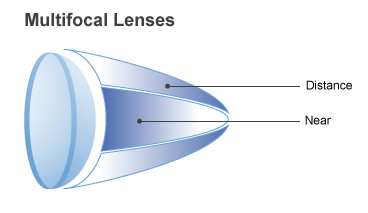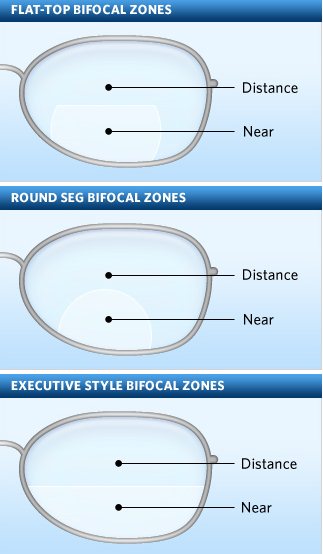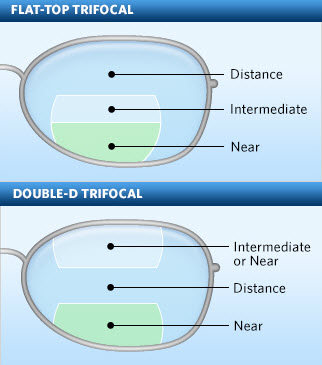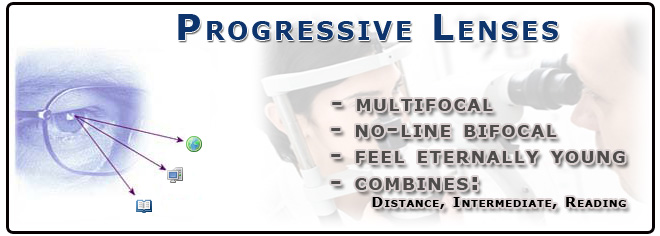Just as eyeglass frames have a trend set in making the world more fashionable, eyeglass lenses also evolved its pattern in creating fashion as well as vision correction. This fact is true for multifocal lenses because these lenses come with more than one lens power to help those over the age of 40 years with age-related near vision problem called presbyopia. If you’re wearing prescription eyeglasses already, it means that you need to wear multifocal lenses to see correctly and clearly at all distances. Multifocal lenses are usually prescribed for adults over age of 40 to compensate for presbyopia, but in few cases these lenses are prescribed for children and young adults who have focusing or eye teaming problems that may cause severe eye strain while reading or performing any activity. In some children, multifocal eyeglass lenses control myopia by reducing the focusing effect of reading and doing near work. Read this article to know the history, features and types of multifocal eyeglass lenses that are designed for particular purposes.
History of Multifocal Eyeglass Lenses
Benjamin Franklin is the early inventor and an American statesman who attributed in creating the first multifocal eyeglass lenses. People with presbyopia had to carry two pairs of eyeglasses – one for seeing distant objects and the other for seeing close objects. In 1780, Franklin cut two lenses in two halves and ligated them together, and he named it as bifocal lens. Initially, it was called the Franklin bifocal and later due to the lens design, it was named the Executive bifocal.
In the 19th and 20th century, the Franklin bifocal lens design was refined and became smaller. Round bifocal segments for near vision were developed, and techniques were invented to correct distance vision. However, these lenses ultimately affected intermediate vision resulting in blurred state after reaching the age of 50. In 1940’s bifocals were compensated with trifocals invention to solve this problem.
Trifocal lenses feature a second small lens segment placed directly above the near part with three power zones. Finally, a combination of bifocals and trifocals with all lens features and designs was invented to resolve the presbyopia condition for people above age 50.
Special Features of Multifocal Lenses for Your Eyeglasses
The term “multifocal” indicates the lenses with no visible line, which is used to correct distance vision at arm’s length and close up viewing. Multifocal lenses generally combine three different prescriptions in one clear lens, allowing you to see comfortably and clearly at all distances. Here are the three unique features of multifocal eyeglass lenses.
- Distance Vision: It is present in the upper part of the lens of your eyeglasses. There will be a small amount of soft focus at the edges of your vision.
- Arm’s Length Vision: This distinctive vision feature is present through the middle part of the lens of your eyeglasses. There will be the softest focus at the edges of your vision in this part of your lens.
- Near Vision: It is present in the lower part of the lens of your eyeglasses. There will be minute soft focus at the edges of your vision in this part of your lens.
Different Types of Multifocal Eyeglass Lenses
Whether it is near or far vision, personalizing your lens can make a significant impact on the way you see the objects and perform your work. It is a great thing that today’s lens technology not only provides you custom vision but also offers you the perfect lens that can make your daily lifestyle clear and comfortable. It’s quite common that before you purchase any eyewear, you’ll need to know about the options of your eye needs. Likewise, multifocal lenses have different options to correct your vision. Have a look at them.
- Bifocal Lens: Bifocal eyeglass lenses have two lens powers – one for distance purpose and the other for near vision. The lower half of a bifocal lens contains the near segment for reading and another close up works like driving. The remaining part of the lens is usually for distance correction. Another popular fused bifocal is the round segment bifocal. The advantage of these bifocals is that the line separating the distance and near zones of the lens tends to be less prominent than the upper edge of a distance segment bifocal.

- Trifocal Lens: Trifocal eyeglass lenses possess an additional ribbon-shaped lens segment distinctly above the near segment for seeing objects in the intermediate level of vision which is approximately 18 to 24 inches away. Trifocals are especially helpful for people who are suffering from presbyopia condition and those who have less depth of focus on objects. The trifocal lens offers a third focal point that is not covered by the top or bottom correcting segments. Usually, this lens type has two segment.

- Progressive Lens: Progressive eyeglass lens is true multi-focal lens that eradicate segment lines for a smooth transition between correcting segments. These lenses offer a large number of powers for clear eye sight and clarity of vision at all distances. The wearer’s vision is more comfortable and natural because there is no image jump due to the absence of visible lines of lens power in a progressive.

- Occupational Lens: Occupational multifocal lenses are designed for performing a specific job or regular habitual action and are not used for general purpose wear. The most popular occupational multifocal lens is “Double – D.” This type of lens has an upside down flat top segment for intermediate or near vision in the top third of the lens and a second flat top segment for near vision in the bottom third. In few cases, a standard multifocal lens can become an occupational lens by altering the way it is placed in your eyeglass frame.
The right and perfect multifocal lenses for your eyeglass will depend basically on your age factor, visual needs, and your budget. Visit your eye care specialist before you purchase bifocal, trifocal, progressive or occupational multifocal lenses and get a customized solution to your clear vision and eyewear needs.
Image Credits: static.visiondirect.info, md-health.com, eyedoctorguide.com
